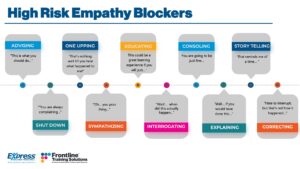How the Power of Listening can Empower the Workforce
Written by Nic Dampier

The Imperfect Art of Listening
We’ve all been there – our thoughts drifting as someone speaks, our heads nodding in autopilot while we think of what’s for lunch, or our minds forming the next question before the other person has finished speaking. On the flip side – how often have we experienced those moments where we felt unheard, especially at work?
The sad truth is listening isn’t always that straightforward. A recent study revealed alarming statistics: 83% of employees think they aren’t heard “fairly or equally” at work, while 41% left a job because they didn’t feel listened to. Another study showed that 87% of business leaders believe listening is one of the most crucial qualities of a good leader, yet only 2% have invested in training to improve it. This revelation sparks a pressing question: Are we genuinely listening? If not, how can we do it better?
In a world filled with noise and distractions, the art of listening with purpose is invaluable. It’s a fundamental skill that can transform your relationships by opening the door for effective communication and allowing you to understand and connect with others on a deeper level. As a leader, when you actively listen to your employees, you embark on the journey of human-centered leadership that treats employees as individuals deserving of respect, empowerment, and trust.
The Three Pillars of Human-Centered Leadership
The human-centered leadership style values the human aspect of work. It recognizes that employees are not resources but individuals with unique needs and aspirations. Human-centered leaders place people at the center of their leadership strategies, with a focus on building meaningful relationships and empowering their teams for success. These leaders aim to make their employees feel valued, understood, and supported, creating a positive workplace culture that inspires greater job satisfaction, engagement, and productivity.
Human-centered leaders are characterized by three main qualities:
- Authentic
Authentic leaders are true to themselves, their values, and their principles. They lead with transparency and integrity and build trust by demonstrating consistency between their words and actions. These leaders rely on a deep introspection of their strengths, weaknesses, motivators, and demotivators to drive their interactions with others.
- Empathetic
Empathetic leaders possess the ability to understand and share the feelings and perspectives of others. They’re attentive to the emotional and social dynamics of others and listen and respond to their teams’ needs. These leaders create a supportive environment that boosts team morale and well-being.
- Adaptive
Adaptive leaders can adjust and respond to changing circumstances and challenges. They have a keen awareness of how change impacts their teams’ requirements and take proactive steps to cater to these evolving needs. These leaders foster a work environment that is flexible and supportive, encouraging their teams to remain resilient and thrive through times of uncertainty or change.
The path to becoming a human-centered leader is not easy and requires a lot of self-awareness and commitment. But the first step you can take is to listen – to really, mindfully listen. When you actively listen to others, you not only forge a deeper connection but also prioritize their needs, thereby fostering your growth as a more effective human-centered leader.
Why Listening with Purpose Makes You a Better Leader
Listening isn’t merely a soft skill. One can almost argue that it’s the most critical skill in any leader’s communication toolbox, as it lays the foundation for developing other interpersonal skills like emotional intelligence, communication, and teamwork. Amongst other benefits, improving your listening skills can help you:
- Build trust with the people in your circle of care.
- Resolve conflict by listening to others’ ideas and proposed solutions.
- Prevent you from missing important information.
- Anticipate problems by recognizing the concerns and challenges of others.
- Gain knowledge about what your employees are going through.
- Improve productivity by influencing, negotiating, and persuading when you understand the needs and motivations of those you’re engaging with.
- And above all – listening with purpose enables you to help and care for others!
Now Ask Yourself – Are You Really Listening?
We think we’re listening. We sit there, patiently, waiting for the other person to finish, and we pride ourselves on being able to repeat everything back word for word.
But does that mean we actually understood what was said?
Listening is more than hearing words; it’s also about paying attention to the speaker’s nonverbal cues, emotions, and the overall message being conveyed. When you listen with purpose, you engage with the speaker to focus, understand, and respond to them.
Being aware of your listening behaviors will impact the success of your conversations. You can become a better listener by avoiding these behaviors:
- Inattentive or Passive Listening:When you’re listening to someone, are you busy doing something else? Are you checking your emails, texting, or thinking about another matter? Imagine how you’d feel if you were the speaker, and the listener wasn’t giving you their full attention. This scenario will hardly foster trust or a genuine connection.
- Parroting or Pretend Listening:Unlike a rote lesson, we shouldn’t listen just to repeat everything that was said. While it may be well-intentioned, this behavior diminishes the depth and engagement that meaningful dialogue requires and prevents us from grasping the underlying message.
- Selective Listening/Listening to Solve:When you selectively listen, you’re focusing just on specific parts of the message while filtering out other points. Selective listening often occurs when you’re only interested in the information or aspects of the conversation that align with your interests, opinions, or goals. Being aware of this behavior can prevent misinterpretations, missed nuances, or disengagement between the speaker and the listener.
- Listening to Respond: When you’re thinking of what or how to reply to the speaker, you’re not giving your full attention to them. Rather than trying to empathize with what the speaker is saying, you’re thinking of your contributions, counterarguments, or clarifications on the subject. While it may seem as if you’re engaged in the conversation, focusing on your own responses instead of what the other is saying could prevent you from realizing the complete story that is being told.
On the other hand, practicing the following behaviors will improve your skills as an active listener:
- Attentive Listening/Listen to Understand: Undoubtedly, the first rule of thumb for listening is to be present. Give your full focus and concentration to the speaker and their message. Get rid of all distractions, and seek to appreciate the speaker’s perspective, emotions, and the context of their communication.
- Paraphrasing/Cognitive Response:This occurs when we reflect on what someone has said and rephrase it for clarity. During this process, we relate what we hear to our own experiences to help us empathize with the speaker. This approach revolves around absorbing their words while focusing on their perspective.
- Empathetic Listening/Feeling with Someone: When you listen with empathy, you’re identifying with the speaker’s perspectives and emotions and letting them know you understand without imposing judgment. Try putting yourself in their shoes and think about how you’d react if you were in the same situation, or how you’d want your listener to reply. Refrain from using these high-risk empathy blockers that derail you from getting the real message:

Once you can tell the speaker “I understand how you feel” and seriously mean it, you’ve gone beyond mere words to become attuned to their underlying thoughts and feelings. Being able to do so equips you to build meaningful relationships, offer support, and contribute to the emotional well-being of those around you.
A Reflective Response Checklist
To ensure you engage in the behaviors required for purposeful listening, use the following checklist as a guide:
- Check and Be: Be adaptable to the speaker’s needs, whether it’s a formal private conversation or a relaxed walk-and-talk. Check your presence to ensure you’re mentally engaged with the speaker and use encouragers to keep the conversation flowing, such as “Uh-huh”, “Really?”,” Go on”, or “Tell me more”.
More importantly – be aware of your nonverbal cues. Research has shown that 70% to 93% of all communication is conveyed through nonverbal means such as facial expressions and gestures. Ensure you maintain eye contact and that your tone and body language put the speaker at ease with sharing their thoughts.
- Remember: During a conversation, remind yourself of the power of silence. Being silent is not about keeping quiet; it’s also about quieting your thoughts so that you can give the speaker your undivided attention.
Sometimes, there may be breaks in the conversation where the speaker hesitates. This doesn’t mean that the discussion is over, but that they’re trying to collect their thoughts before sharing. In these moments, resist the urge to interject. Keeping silent conveys the message you’re invested in the conversation and are prepared to give them the time and space they need to share.
And always, always remember – never interrupt! Interrupting the person while they’re speaking not only shows impatience but also gives the impression that your thoughts are more important than theirs.
- Respond: Responding is essential but refrain from introducing new content. Your goal should be to reflect on what you’ve heard and not to share your own experiences or ideas immediately. Think of it as trying to understand others first before making them understand you. This approach allows the conversation to revolve around the speaker, their thoughts, and their feelings. By using encouragers and maintaining silence, you’re enabling them to share more and open up on their terms. Using phrases like “It sounds to me like…” or “So if I’m understanding you…” can help you clarify and be aware of what is being said.
- Target: Now that you’re armed with insights and a checklist for improving your listening skills, it’s time to put a plan into motion. Breaking down your strategy into the following 3 steps will help you apply what you’ve learned in your daily interactions:
Step 1: Focus Area: What aspect of listening will you concentrate on improving? Which specific behavior will be your focal point? E.g., I will not interrupt when others are speaking.
Step 2: Definitive Goal: What outcomes or improvements are you aiming for? What positive changes do you envision will happen as a result of improving this behavior? E.g., I’d like to make others more comfortable in sharing their honest thoughts with me.
Step 3: Action Steps: What precise strategies can you employ to bring about this improvement? E.g., When I’m about to interrupt, I will remind myself of the power of silence and give the speaker the time and space to speak.
Ready to Listen with Purpose?
As you consider your action plan to become a better listener, consider the impact of this change in fostering an inclusive work culture that values every employee’s contribution. Such an environment increases trust and collaboration and forms stronger professional relationships. When employees feel genuinely heard, they’re more likely to stay with the organization, reducing turnover and promoting long-term stability.
For more valuable insights and strategies on purposeful listening, watch our webinar featuring Dayna Neff, Client Relations Manager/Senior Facilitator at Frontline Training Solutions. If you’re ready to take the next step and explore tailored insights and solutions, contact us to discover how we can assist you in mastering the art of listening to become better human-centered leaders.
Start Your Training Today
Trusted by professionals just like you.
About the Author
Nic Dampier
Nic Dampier understands the value of good storytelling and the impact this has on brand identity and community. As the Director of Marketing for Express Employment Professionals of Grand Rapids, as well as Frontline Training Solutions and the Grand Rapids, Michigan location of Specialized Recruiting Group, he is responsible for the strategic direction, vision, and branding of all marketing and communication initiatives. He has a passion for storytelling with excellence and helping brands become scalable and sustainable. Nic is a graduate of Mississippi State University with a Degree in Strategic Communication Management and is focused on developing brand strategy that cuts through the noise by following a communication filter he designed called C.R.I.C.K.E.T., which stands for brand messaging that is Clear, Relatable, Intentional, Consistent, Kinetic, Engaging, and Truthful. Nic is also a veteran of the United States Navy, where he served as a Religious Program Specialist Petty Officer Second Class immersed in the middle east culture learning how to communicate across cultural boundaries. After the Navy, he spent a decade serving as a Creative Arts Pastor for a large multi-site church network telling stories of the church and directing the production/music experience for thousands of people in person and online. He is an accomplished destination wedding and brand filmmaker of 13 years. Most recently he was featured in the 2021 ArtPrize International Art Competition as a “must see,” by local news where he won 97 individual fan-favorite awards for his entry featuring 19 stories overcoming various adversity and struggles like homelessness, alcoholism, and prison through…

